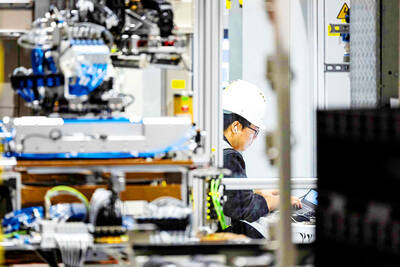Minister of Economic Affairs Lin Yi-fu (林義夫) announced yesterday that electricity rates for the summer months will drop by a bigger margin and that one rate level will be added to the existing three levels.
Lin made the announcement after he led officials of the state-owned Taiwan Power Co (Tai-power, 台電) in making a report to the DPP legislative caucus about its rate-cut proposal.
Presently there are three rate levels: those who use less than 110 kilowatt hours, those who use between 110 kilowatt hours and 330 kilowatt hours and those who use more than 331 kilowatt hours. A level between 331 kilowatt hours and 500 kilowatt hours will now be added.
Under the new system, a household using fewer than 110 kwh per month would pay NT$0.2 less to NT$2 per kilowatt-hour (kwh). Those using between 110kwh and 330kwh per month would pay NT$0.1 less to NT$2.6 per kilowatt-hour. Usage between the 331kwh to 500kwh per month will be subject to NT$3.3 per kilowatt hour, which will be cut by NT$0.1 per kilowatt-hour. For users in the over-500kwh bracket, the rate will remain the same at NT$3.3 per kilowatt-hour.
Lin said that the new rates will be retroactive to June 1, the start of summer electricity rates.
DPP Legislator Chao Yung-ching (趙永清) said that Taipower has a bigger surplus than expected every year and should be able to afford to cut its rates.
Chao also asked that the off-peak time span should begin earlier than 10:30pm. Taipower officials said that this would result in losses of between NT$5 billion and NT$6 billion (US$144.92 million to US$173.91 million) and would need further study.

CHIP RACE: Three years of overbroad export controls drove foreign competitors to pursue their own AI chips, and ‘cost US taxpayers billions of dollars,’ Nvidia said China has figured out the US strategy for allowing it to buy Nvidia Corp’s H200s and is rejecting the artificial intelligence (AI) chip in favor of domestically developed semiconductors, White House AI adviser David Sacks said, citing news reports. US President Donald Trump on Monday said that he would allow shipments of Nvidia’s H200 chips to China, part of an administration effort backed by Sacks to challenge Chinese tech champions such as Huawei Technologies Co (華為) by bringing US competition to their home market. On Friday, Sacks signaled that he was uncertain about whether that approach would work. “They’re rejecting our chips,” Sacks

It is challenging to build infrastructure in much of Europe. Constrained budgets and polarized politics tend to undermine long-term projects, forcing officials to react to emergencies rather than plan for the future. Not in Austria. Today, the country is to officially open its Koralmbahn tunnel, the 5.9 billion euro (US$6.9 billion) centerpiece of a groundbreaking new railway that will eventually run from Poland’s Baltic coast to the Adriatic Sea, transforming travel within Austria and positioning the Alpine nation at the forefront of logistics in Europe. “It is Austria’s biggest socio-economic experiment in over a century,” said Eric Kirschner, an economist at Graz-based Joanneum

BUBBLE? Only a handful of companies are seeing rapid revenue growth and higher valuations, and it is not enough to call the AI trend a transformation, an analyst said Artificial intelligence (AI) is entering a more challenging phase next year as companies move beyond experimentation and begin demanding clear financial returns from a technology that has delivered big gains to only a small group of early adopters, PricewaterhouseCoopers (PwC) Taiwan said yesterday. Most organizations have been able to justify AI investments through cost recovery or modest efficiency gains, but few have achieved meaningful revenue growth or long-term competitive advantage, the consultancy said in its 2026 AI Business Predictions report. This growing performance gap is forcing executives to reconsider how AI is deployed across their organizations, it said. “Many companies

France is developing domestic production of electric vehicle (EV) batteries with an eye on industrial independence, but Asian experts are proving key in launching operations. In the Verkor factory outside the northern city of Dunkirk, which was inaugurated on Thursday, foreign specialists, notably from South Korea and Malaysia, are training the local staff. Verkor is the third battery gigafactory to open in northern France in a region that has become known as “Battery Valley.” At the Automotive Energy Supply Corp (AESC) factory near the city of Douai, where production has been under way for several months, Chinese engineers and technicians supervise French recruits. “They